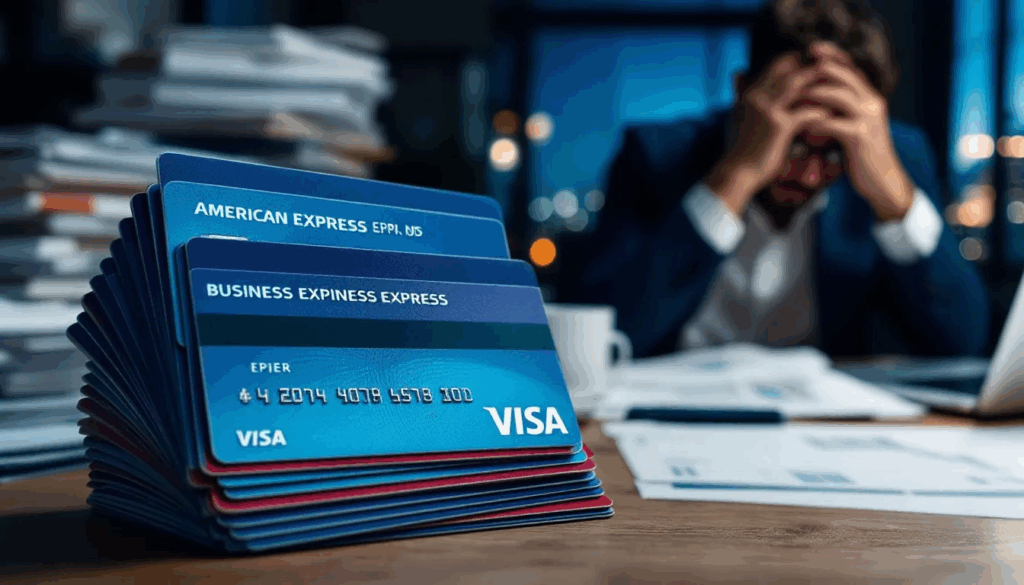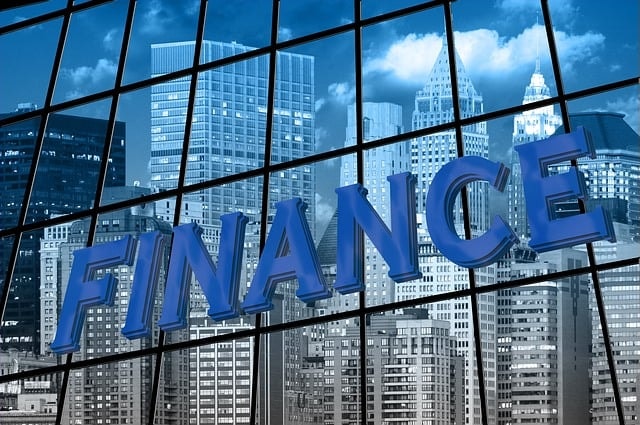What is Business Credit Card Stacking?
Credit card stacking refers to establishing an unsecured business line of credit by opening multiple credit card accounts in a specific order. The process is an alternative to traditional small business funding. It allows you to establish multiple credit lines, and it involves managing several accounts.
Credit card companies are often more flexible than traditional small business lenders, like banks and credit unions. With more lenient qualifications and faster approval times, small business owners can use a stacking strategy to quickly gain the necessary funding.
The best business credit cards include special perks and bonuses, such as 0% introductory APRs, cash back rewards, or discounts at specific business-to-business (B2B) vendors and supplies. Using a stacking strategy effectively can also help establish and build business credit for more advantageous financing solutions in the future.
However, like all financing products, credit card stacking isn’t for everyone and carries risks. Credit card APRs can get very expensive, and falling behind on payments will damage your credit. Strategically applying for credit cards can help mitigate the negative effect of hard inquiries on personal credit reports.
How does Credit Card Stacking work?
Determine What You Qualify For
While credit card companies are flexible on revenue and time in business requirements, you’ll still need good credit in most cases. The best business credit card options usually require a minimum personal credit score of 680+. Most lenders only consider your personal credit and don’t look at business credit scores.
Beyond credit scores, you can also look at what credit card issuers are best for your type of business. Some business cards offer industry-specific rewards and benefits. Some business owners combine personal and business cards or use secured business credit cards.
Shop Lenders and Cards
Part of the process involves researching the best card options and lenders. When deciding on a card, you should compare costs, rewards, and other factors. Working with a stacking company can help you research your available options.
Apply
When you work with a stacking company, it takes care of submitting the applications for you. If working on your own, you must individually complete the applications. You’ll usually apply for multiple credit cards simultaneously, typically 5-15.
Approval
You’ll typically get a response to your application(s) quickly. Some can give you instant approval, while others might take up to 48 hours. Once approved, you can usually receive the card(s) in 3-10 business days, although many card companies will let you immediately use the digital version of the card.
Credit Limit
Each card comes with a set credit limit. Businesses that require stacking typically can’t get approved for a high-balance credit card or line of credit. You’ll have to manage the credit line on each card when using them to pay for business expenses.
Best practices suggest spreading credit card debt across accounts so your utilization isn’t too high on any one card. However, some people suggest loading the balance on the credit card with the lowest interest rate.
Fees, APRs, and Accrued Interest
Credit cards use an APR, with most ranging from 15% to as high as 35%. Some cards also include fees, such as annual fees or cash advance fees. If you use a stacking company, it will typically charge a fee between 9% and 12% of your credit limit. The interest rates on credit cards can be high once introductory offers expire, leading to potential debt accumulation.
You accrue interest on a monthly billing cycle. Paying your balance in full prevents interest charges. The minimum monthly payment is typically 1-2% of your total balance. Be careful about only making the minimum payment, as you’ll end up paying a lot in interest.
Rewards, Perks, and Bonuses
One advantage of commercial credit cards is that many offer a rewards program to attract and retain customers. As mentioned, several business credit cards offer an introductory 0% APR, although fees still apply. The introductory period is usually between 6 and 22 months, but some go up to 24 months.
You should also look for cards that offer cash back rewards. Used appropriately, cash back can help offset some of the card’s costs. Other bonuses might include discounts for using the card with specific vendors or free balance transfers.
Who should use Credit Card Stacking?
Credit card stacking isn’t a viable funding strategy for every small business, but it sometimes makes sense. Here are some scenarios where using stacking is a reasonable option.
Businesses That Can’t Qualify for a Loan
Traditional business loans include business term loans, business lines of credit, equipment financing, and SBA loans. Most traditional lenders require at least two years in business, high revenue, and an excellent business credit score to qualify. Companies that struggle to meet those requirements often turn to alternative funding solutions.
Some alternative funding options, like merchant cash advances or invoice factoring, might also be unavailable, depending on the nature of your business, revenue, or time in operation. In those cases, credit card stacking could be a good idea. For example, low-revenue businesses might need to use stacking.
Businesses with an Urgent Funding Need
Even if you qualify for a traditional business loan, it can take weeks to months to close and fund it. Alternative financing options, like stacking or a loan from an alternative lender, can provide much faster funding times.
Businesses with No Collateral
One of the many benefits of stacking business credit cards is that it doesn’t require collateral. This is known as unsecured financing. Financing with collateral is called secured because the collateral provides security for the lender in case of a default.
Many lenders require businesses to pledge collateral for a traditional business loan. Examples include commercial real estate, business equipment, and other fixed assets. However, many businesses don’t have collateral to pledge and must pursue unsecured financing.
Startups
New businesses often struggle to obtain business financing. Most lenders want to see proven revenue streams and at least one to two years in operation. That’s because most new businesses fail within the first two years.
Entrepreneurs without an established business credit history can sometimes stack credit cards to effectively use them as a line of credit. Once the business drives revenue, you can use the funds to repay what you put on the card. Establishing revenue and building your personal and business credit by paying down the cards will open the door to traditional financing.
What are the benefits of Credit Stacking?
Credit cards are unsecured. You can usually take advantage of introductory APRs and various rewards and bonuses. At the same time, carrying available credit and paying off your cards can help establish and grow business credit.
Most credit cards provide fast approval and funding times. It can help quickly provide a line of credit for business essentials, such as office supplies, inventory, and more.
Having multiple credit accounts for business expenses also helps with budgeting and debt management. It provides greater flexibility in how and when you use your credit.
What are the drawbacks of Credit Card Stacking?
What are the drawbacks of Credit Card Stacking?
In most cases, you’ll still need good credit, usually 680 or better. While introductory APRs can save money, the standard APRs are typically much higher than business loan interest rates.
Stacking credit cards means keeping track of different balances, due dates, and rewards programs. Monitoring the credit activity can be time-consuming and difficult. Business credit cards tend to have high interest rates after any introductory period.
It can be challenging to manage multiple accounts with business debt. Most cards require a personal guarantee, which is a promise to repay the debt even if the business fails. If you default on the business card debt, the credit card company could pursue the assets of the personal guarantor.
Pros and Cons
Here’s a quick summary of the advantages and disadvantages of stacking.
Pros:
- It can help establish and build business credit.
- Provides unsecured financing.
- Introductory APRs & rewards programs.
- Fast approval and funding times.
- Improved budgeting & greater flexibility.
Cons:
- Usually requires a credit score of 680 or better.
- APRs and fees are higher than most business loan interest rates.
- Requires monitoring different balances, due dates, or fees.
- Might require a personal guarantee.
- It might include an annual fee.
How can my business effectively use Credit Card Stacking?
Credit card stacking can be an effective business funding strategy, but it requires planning and discipline. Running up balances too high can lead to payments that your cash flow can’t afford, and being overleveraged can put your business at risk.
Here are some strategies and tips to help ensure you use business stacking responsibly.
Create a Budget & Track Expenses
Planning and sticking to a budget can help prevent you from overspending on your credit cards. Part of the budget plan should include how you track your expenses. Using multiple cards to cover various expenses can make it difficult. Keep a spreadsheet of all expenses in one place to ensure you’re tracking them on time.
Paying Your Balance On Time, Due Dates, & Automatic Payments
Ideally, you would pay off the entire balance each month to avoid interest charges. At the very least, you should make your minimum monthly payment to avoid significant charges and a negative credit report. Even one missed credit card payment can damage your credit.
Consider setting up automatic payments to ensure you never miss a due date. When possible, pay off more of the balance with a manual payment.
You should also keep track of your due dates. Using multiple credit cards means having different due dates throughout the month. Consider using a spreadsheet or accounting software to track all due dates.
Use Your Rewards
You should create a plan to maximize the rewards that come with your credit card. You can build using credit card points into your budget. Effectively using credit card rewards helps offset the costs of stacking credit cards.
Keep Personal and Business Expenses Separate
One of the main reasons to stack business credit cards rather than personal credit cards is to keep your finances separate. Likewise, avoid using your business card for any personal expenses.
Choose Your Repayment Strategy: Snowball or Avalanche
When you carry multiple balances on multiple cards, you can choose to pay off the smallest one first (snowball) or pay off the highest balance first (avalanche). Some financial experts suggest using the snowball approach because paying off one balance will give you a sense of accomplishment that can lead to paying off the remaining balances.
Other experts feel it’s important to tackle the largest debt first. Both strategies are viable, but you must pick one and stick to it.
Frequently Asked Questions
Here are the most common questions about stacking business cards.
What is a Credit Card Stacking company?
A credit card stacking company helps businesses obtain a line of credit funded through multiple business credit cards. If you see a company that advertises large, unsecured lines of credit, they’re typically credit card stacking companies. Credit card stacking companies charge fees ranging from 9% to 15% of the approved credit limit for their services.
Working with a reputable credit stacking company has its advantages. They are usually adept at matching you with the cards that best meet your business profile and help you navigate the various rewards programs, payment processes, and due dates.
Also, they can help you apply for multiple credit cards at once so that the applications don’t impact your personal credit history until after you’re approved. Most will look for cards not reported on personal credit reports to protect personal credit scores.
However, it would be best if you were careful, as there are some less reputable companies offering stacking services. Look out for over-the-top promises about rates, funding amounts, or approval requirements. Some will charge exorbitant fees, although the servicing fee can run high even with reputable companies.
Another major red flag is any stacking company that asks you to lie about your income to get approved. Not only is that unethical, but it can also create legal troubles.
Is Credit Card Stacking legal?
Stacking credit cards is legal in and of itself. As a consumer, you can apply for as many credit cards as you want. However, as mentioned, lying or exaggerating about income or other factors to get approved can land you in legal jeopardy, including perjury charges.
Can I combine credit limits from multiple Credit Cards?
No, merging credit limits from multiple credit cards into a single credit limit is impossible. Credit card companies base your credit limit on factors such as income and creditworthiness. That’s why it’s sometimes necessary for a low-revenue business to stack credit cards if no one credit card can provide the larger unsecured line of credit you need. When stacking credit cards, you must manage each credit limit, balance, payment, and due date separately.
How many Business Credit Cards can I have?
Again, there’s no limit to the number of credit cards you can obtain. However, most strategies suggest a credit card stack between five and fifteen credit cards. Some business owners like to avoid going into the double digits.
Limiting the number of credit cards you get to only what you need would be best. Each credit card application results in a hard credit inquiry, which can damage your credit. In addition, having more options makes it too tempting to drive up credit balances beyond what your business can afford.
On the other hand, you should also avoid opening too few credit cards. You want to ensure you have the available credit to cover your expenses. Moreover, part of your credit score is based on your credit utilization, which refers to your current balances over your credit limit.
Credit utilization should be 30% or lower. So if you have a credit card with a $10,000 credit limit, you don’t want a balance above $3,000. Taking out too few credit cards results in a lower total available credit, which can cause your utilization to go over 30%.
What are the alternatives to Credit Card Stacking?
Stacking credit cards is one alternative funding strategy, and in some cases, might be your best option. However, there are other small business financing options to consider.
Merchant Cash Advance
- Funding amounts: $5k – $1 million.
- Factor rates: 1-6% p/mo.
- Terms: 3 – 24 months.
- Funding time: 1-2 business days.
One of the most accessible forms of alternative business funding is the merchant cash advance (MCA). It’s technically not a loan. Instead, a financial services provider called an MCA company or MCA funder purchases a percentage of your receivables at a discounted rate in exchange for a lump sum cash advance.
Most MCAs use a factor rate to determine your repayment amount. Factor rates range from 1.05-1.9. Multiply the advance amount by the factor rate to determine your costs.
For example, if you received an MCA for $50,000 at a factor rate of 1.2, you’d calculate your repayment amount as follows:
$50,000 x 1.2 = $60,000, meaning you’d repay $10,000 in addition to the principal. While you can think of the $10,000 as “interest,” it’s actually the MCA company purchasing $60k in receivables for $50k.
Repayment comes directly from your daily credit card sales or revenue. The percentage of your daily sales that goes to the MCA company is called the holdback rate.
Approved businesses we work with here at UCS typically meet the following minimums for a merchant cash advance:
- Credit score: 550+.
- Time in business: 4 months+.
- Annual revenue: $120k+.
Bad Credit Business Loans
- Funding amounts: $5k – $5 million.
- Factor rates: 1-6% p/mo.
- Terms: 3 months – 5 years.
- Funding time: 1-3 business days.
Another option might be a bad credit business loan, particularly since stacking credit cards usually requires a good credit score. Alternative lenders can often approve small business owners with poor credit because of flexible underwriting requirements.
Bad credit business loan options include various working capital and equipment financing solutions. The drawback to these loans is that they usually have high rates and fees. In nearly every financing situation, the lower your credit score, the higher the interest rate.
One way to approach bad credit business loans is to treat them as a form of bridge financing. Much like stacking credit cards, you can use this method to provide short-term working capital while building your credit and business history to qualify for a traditional small business loan.
Approved businesses we work with here at UCS typically meet the following minimums:
- Credit score: 475+.
- Time in business: 6 months+.
- Annual revenue: $240k+.
Other Small Business Loans
In addition to the above options, qualified business owners might consider one of the following small business loans:
- Business term loans
- Business lines of credit
- Equipment financing
- SBA loans
- Working capital loans
- ERC advance
Business Credit Card Stacking – Final Thoughts
Using a stacking strategy can sometimes be an effective business financing strategy. However, many risks are involved, and a small business owner must develop a plan to avoid those financial pitfalls.
Small business owners with decent credit who otherwise struggle to obtain business loans, whether because they don’t have the time in business, revenue, or other reasons, should consider credit card stacking. You can likely qualify for more advantageous business financing options with good credit, more than a few months in business, and decent annual revenue.
Contact us if you want to apply for a small business loan. Our loan executives can help you determine the best way to get funding for your business.














